Prediction of Oil Sorption Capacity on Carbonized Mixtures of Shungite Using Artificial Neural Networks
Abstract
:1. Introduction
2. Materials and Methods
2.1. Preparation of Oil-Contaminated Soil Samples
2.2. Modeling Using Artificial Neural Networks
2.3. Sorption Modeling with ANNs
3. Results and Discussion
3.1. Experimental Results
3.2. ANN Training and Testing Results for Modeling Oil Sorption
3.3. Results of ANN Sorption Prediction for Oil-Contaminated Soil
4. Conclusions
Author Contributions
Funding
Data Availability Statement
Conflicts of Interest
References
- Xuezhi, D.; Ahmad, A.A.; Muhammad, I.; Shah, T.; Kalwar, Q. Remediation Methods of Crude Oil Contaminated Soil. World J. Agric. Soil Sci. 2020, 4, 000595. [Google Scholar] [CrossRef]
- Amro, M.M. Treatment Techniques of Oil-Contaminated Soil and Water Aquifers. In Proceedings of the International Conference on Water Resources & Arid Environments, Riyadh, Saudi Arabia, 5–8 December 2004. [Google Scholar]
- Vasilyeva, G.K.; Zinnatshina, L.V.; Kondrashina, V.S.; Strijakova, E.R.; Filonov, A.E.; Sushkova, S.N. Use of adsorbents for accelerated bioremediation of petroleum-contaminated soils. Int. J. Appl. Sci. Res. Rev. 2018, 5, 29–37. [Google Scholar]
- Okoh, E.; Yelebe, Z.R.; Oruabena, B.; Nelson, E.S.; Indiamaowei, O.P. Clean-up of crude oil-contaminated soils: Bioremediation option. Int. J. Environ. Sci. Technol. 2019, 17, 1185–1198. [Google Scholar] [CrossRef]
- Elizaveta, M.; Maria, U. Ecological aspects of sorbents use to improve the efficiency of bioremediation on oil-contaminated lands. Rev. Fuentes Revent. Energ. 2021, 19, 65–73. [Google Scholar]
- Wang, Y.; Pan, C.; Chu, W.; Vipin, A.K.; Sun, L. Environmental remediation applications of carbon nanotubes and graphene oxide: Adsorption and catalysis. Nanomaterials 2019, 9, 439. [Google Scholar] [CrossRef]
- Sahu, J.N.; Karri, R.R.; Zabed, H.M.; Shams, S.; Qi, X. Current Perspectives and Future Prospects of Nano-Biotechnology in Wastewater Treatment. Sep. Purif. Rev. 2021, 50, 139–158. [Google Scholar] [CrossRef]
- Bansal, R.C.; Meenakshi, G. Activated Carbon Adsorption; CRC Press: Boca Raton, FL, USA; Taylor & Francis Group: Abingdon, UK, 2005. [Google Scholar]
- Muzarpar, M.S.; Leman, A.M.; Rahman, K.A.; Maghpor, N.; Hassan, N.N.M.; Misdan, N. The Adsorption Mechanism of Activated Carbon and Its Application—A Review. Inst. Res. Innov. Ind. Syst. 2020, 1, 118–124. [Google Scholar] [CrossRef]
- Simonović, B.R.; Aranđelović, D.; Jovanović, M.; Kovačević, B.; Pezo, L.; Jovanović, A. Removal of mineral oil and wastewater pollutants using hard coal. Chem. Ind. Chem. Eng. 2009, 15, 57–62. [Google Scholar] [CrossRef]
- Adebajo, M.O.; Frost, R.L.; Kloprogge, J.T.; Carmody, O. Porous Materials for Oil Spill Cleanup: A Review of Synthesis and Absorbing Properties. J. Porous Mater. 2003, 10, 159–170. [Google Scholar] [CrossRef]
- Kappler, G.; Machado, D.S.; Schröpfer, S.B.; Modolo, R.C.E.; Moraes, C.A.M.; Wander, P.R.; Tarelho, L.A.C. Carbonized rice husk characterization for soil substrate application. In Proceedings of the 7th International Conference on Engineering for Waste and Biomass Valorisation, Prague, Czech Republic , 2–5 July 2018. [Google Scholar]
- Daffalla, S.B.; Mukhtar, H.; Shaharun, M.S. Preparation and characterization of rice husk adsorbents for phenol removal from aqueous systems. PLoS ONE 2020, 15, e0243540. [Google Scholar] [CrossRef]
- Cheenmatchaya, A.; Kungwankunakorn, S. Preparation of Activated Carbon Derived from Rice Husk by Simple Carbonization and Chemical Activation for Using as Gasoline Adsorbent. Int. J. Environ. Sci. Dev. 2014, 5, 171–175. [Google Scholar] [CrossRef]
- Melvin, G.J.H.; Chai, K.F.; Tamiri, F.M. Characterization of carbonized waste materials: Rice husk and saw dust. IOP Conf. Ser. Mater. Sci. Eng. 2019, 606, 012002. [Google Scholar] [CrossRef] [Green Version]
- Silvani, L.; Vrchotova, B.; Kastanek, P.; Demnerova, K.; Pettiti, I.; Papini, M.P. Characterizing Biochar as Alternative Sorbent for Oil Spill Remediation. Sci. Rep. 2017, 7, 43912. [Google Scholar] [CrossRef]
- Sun, S.; Yu, Q.; Li, M.; Zhao, H.; Wang, Y.; Ji, X. Effect of carbonization temperature on characterization and water vapor adsorption of coffee-shell activated carbon. Adsorp. Sci. Technol. 2020, 38, 377–392. [Google Scholar] [CrossRef]
- Bannova, E.A.; Kitaeva, N.K. Development of a Carbon Material Based on Carbonized Peat. Russ. J. Appl. Chem. 2015, 88, 239–243. [Google Scholar] [CrossRef]
- Kovalevski, V.V.; Reinikainen, S.-P.; Reinikainen, V.; Rozhkova, V.S.; Sihvonen, T. Shungite rocks of varying genesis in innovative water treatment technologies. Trans. KarRC RAS 2020, 6, 97–105. [Google Scholar] [CrossRef]
- Yerbolov, S.; Daumova, G. Waste Water Purification from Metal Ions by Ultra-Dispersed Natural Sorbents. J. Ecol. Eng. 2022, 23, 43–50. [Google Scholar] [CrossRef]
- Oliynyk, S.; Mel’nyk, L.; Samchenko, I.; Tkachuk, N.; Loginova, O.; Kisterska, L. Influence of shungite treatment methods on its absorption properties and on water treatment quality for beverages production. Ukr. Food J. 2019, 8, 891–902. [Google Scholar] [CrossRef]
- Efremov, S.; Nechipurenko, S.; Tokmurzin, D.; Kaiaidarova, A.; Kalugin, S.; Tassibekov, K. Remediation of soil contaminated by toxic rocket fuel components using modified carbon-mineral adsorbing material produced from shungite rock modified with Mn4+ and Fe3+. Environ. Technol. Innov. 2021, 24, 101962. [Google Scholar] [CrossRef]
- Saberi-Movahed, F.; Najafzadeh, M.; Mehrpooya, A. Receiving More Accurate Predictions for Longitudinal Dispersion Coefficients in Water Pipelines: Training Group Method of Data Handling Using Extreme Learning Machine Conceptions. Water Resour. Manag. 2020, 34, 529–561. [Google Scholar] [CrossRef]
- Najafzadeh, M.; Homaei, F.; Farhadi, H. Reliability assessment of water quality index based on guidelines of national sanitation foundation in natural streams: Integration of remote sensing and data-driven models. Artif. Intell. Rev. 2021, 54, 4619–4651. [Google Scholar] [CrossRef]
- Reynel-Ávila, H.E.; Aguayo-Villarreal, I.A.; Diaz-Muñoz, L.L.; Moreno-Pérez, J.; Sánchez-Ruiz, F.J.; Rojas-Mayorga, C.K.; Mendoza-Castillo, D.I.; Bonilla-Petriciolet, A.A. Review of the Modeling of Adsorption of Organic and Inorganic Pollutants from Water Using Artificial Neural Networks. Adsorp. Sci. Technol. 2022, 2022, 9384871. [Google Scholar] [CrossRef]
- Mesellem, Y.; Abdallah, A.E.H.; Laidi, M.; Hanini, S.; Hentabli, M. Artificial Neural Network Modelling of Multi-system Dynamic Adsorption of Organic Pollutants on Activated Carbon. Chem. Ind. 2021, 70, 1–12. [Google Scholar] [CrossRef]
- Liao, M.; Kelley, S.S.; Yao, Y. Artificial neural network based modeling for the prediction of yield and surface area of activated carbon from biomass. Biofuels Bioprod. Biorefin. 2019, 13, 1015–1027. [Google Scholar] [CrossRef]
- Sediri, M.; Hanini, S.; Laidi, M.; Turki, S.A.; Cherifi, H.; Mabrouk, H. Artificial Neural Networks Modeling of Dynamic Adsorption From Aqueous Solution. Moroc. J. Chem. 2017, 5, 236–243. [Google Scholar]
- Skrobek, D.; Krzywanski, J.; Sosnowski, M.; Kulakowska, A.; Zylka, A.; Grabowska, K.; Ciesielska, K.; Nowak, W. Prediction of Sorption Processes Using the Deep Learning Methods (Long Short-Term Memory). Energies 2020, 13, 6601. [Google Scholar] [CrossRef]
- Asfaram, A.; Ghaedi, M.; Ahmadi Azqhandi, M.H.; Goudarzic, A.; Dastkhoon, M. Statistical experimental design, least squares-support vector machine (LS-SVM) and artificial neural network (ANN) methods for modeling the facilitated adsorption of methylene blue dye. RSC Adv. 2016, 6, 40502. [Google Scholar] [CrossRef]
- Parsaei, M.; Roudbari, E.; Piri, F.; El-Shafay, A.S.; Su, C.-H.; Nguyen, H.C.; Alashwal, M.; Ghazali, S.; Algarni, M. Neural-based modeling adsorption capacity of metal organic framework materials with application in wastewater treatment. Sci. Rep. 2022, 12, 4125. [Google Scholar] [CrossRef]
- Belhaj, A.F.; Elraies, K.A.; Alnarabiji, M.S.; Abdul Kareem, F.A.; Shuhli, J.A.; Mahmood, S.M.; Belhaj, H. Experimental investigation, binary modelling and artificial neural network prediction of surfactant adsorption for enhanced oil recovery application. Chem. Eng. J. 2021, 406, 127081. [Google Scholar] [CrossRef]
- Alam, G.; Ihsanullah, I.; Naushad, M.; Sillanpää, M. Applications of artificial intelligence in water treatment for optimization and automation of adsorption processes: Recent advances and prospects. Chem. Eng. J. 2022, 427, 130011. [Google Scholar] [CrossRef]
- Ongarbayev, Y.; Baigulbayeva, M.; Tileuberdi, Y.; Ualieva, P.; Abdieva, G. Carbonized Sorbents of Shungite and Rice Husk for Purification of Petroleum Contaminated Soils. J. Ecol. Eng. 2022, 23, 16–25. [Google Scholar] [CrossRef]
- Ongarbayev, Y.; Baigulbayeva, M.; Tileuberdi, Y.; Zhumakhan, K. Sorption of oil by mechanochemically activated shungite. Rud. Geološko. Naft. Zb. 2022, 37, 17–26. [Google Scholar] [CrossRef]
- Cristea, M.; Varvara, S.; Muresan, L.; Popescu, I.C. Neural Networks Approach for Simulation of Electrochemical Impedance Diagrams. Indian J. Chem. A 2003, 42A, 764–768. [Google Scholar]
- Indolean, C.; Maicaneanu, A.; Cristea, V.M. Prediction of Cu(II) Biosorption Performances on Wild Mushrooms Lactarius piperatus using Artificial Neural Networks (ANN) Model. Can. J. Chem. Eng. 2017, 95, 615–622. [Google Scholar] [CrossRef]
- Cristea, M.V.; Roman, R.; Agachi, Ş.P. Neural Networks Based Model Predictive Control of the Drying Process. Comput. Aided Chem. Eng. 2003, 14, 389–394. [Google Scholar]
- Najafzadeh, M.; Niazmardi, S. A Novel Multiple-Kernel Support Vector Regression Algorithm for Estimation of Water Quality Parameters. Nat. Resour. Res. 2021, 30, 3761–3775. [Google Scholar] [CrossRef]
- Najafzadeh, M.; Ghaemi, A.; Emamgholizadeh, S. Prediction of water quality parameters using evolutionary computing-based formulations. Int. J. Environ. Sci. Technol. 2019, 16, 6377–6396. [Google Scholar] [CrossRef]
- Najafzadeh, M.; Ghaemi, A. Prediction of the five-day biochemical oxygen demand and chemical oxygen demand in natural streams using machine learning methods. Environ. Monit. Assess. 2019, 191, 380. [Google Scholar] [CrossRef]
- Najafzadeh, M.; Saberi-Movahed, F.; Sarkamaryan, S. NF-GMDH-Based self-organized systems to predict bridge pier scour depth under debris flow effects. Mar. Georesources Geotechnol. 2018, 36, 589–602. [Google Scholar] [CrossRef]
- Thangavelu, K.; Zou, L. Evaluating oil removal by amphiphilic MoS2/cellulose acetate fibrous sponge in a flow-through reactor and by artificial neural network. Environ. Nanotechnol. Monit. Manag. 2022, 18, 100684. [Google Scholar] [CrossRef]
- Wang, Q.; Bian, J.; Ruan, D.; Zhang, C. Adsorption of benzene on soils under different influential factors: An experimental investigation, importance order and prediction using artificial neural network. J. Environ. Manag. 2022, 306, 114467. [Google Scholar] [CrossRef] [PubMed]

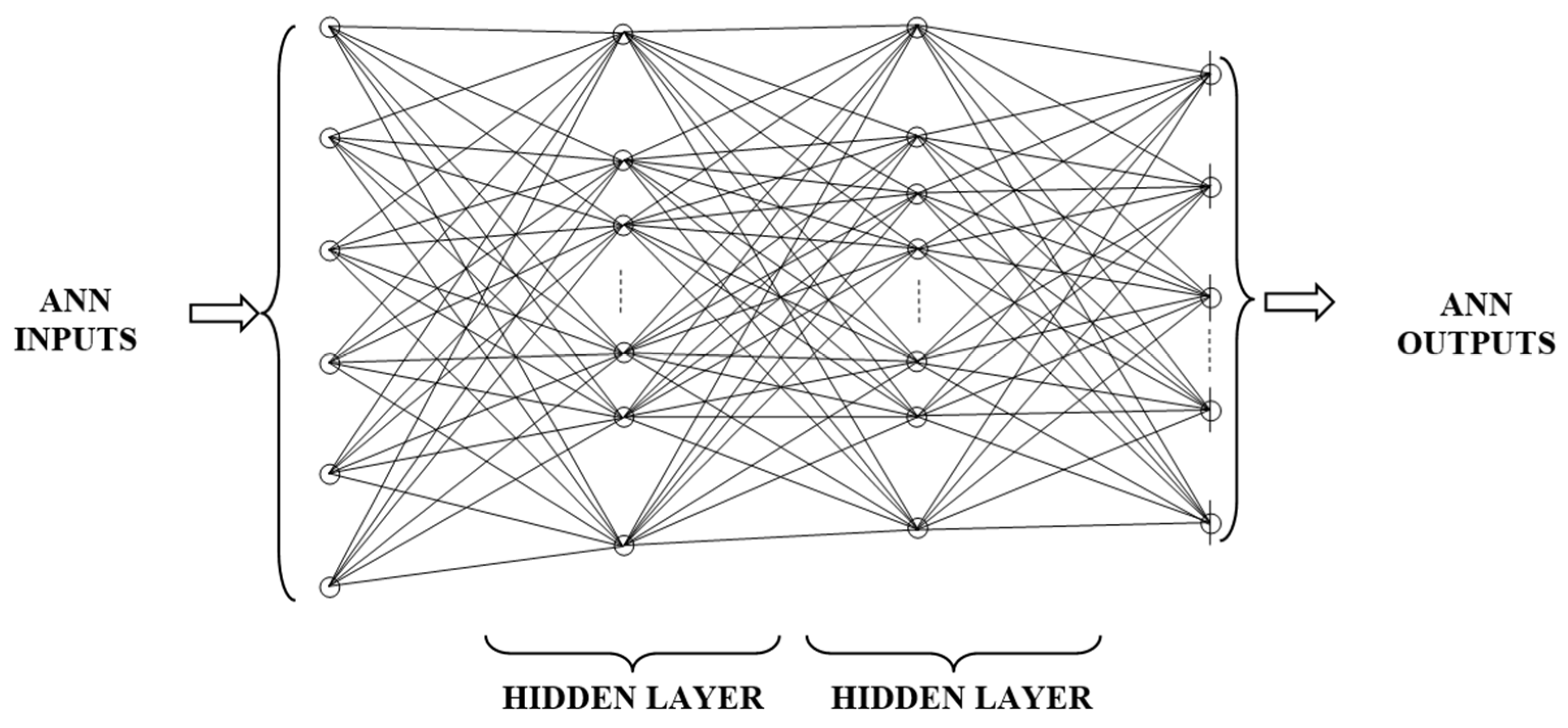

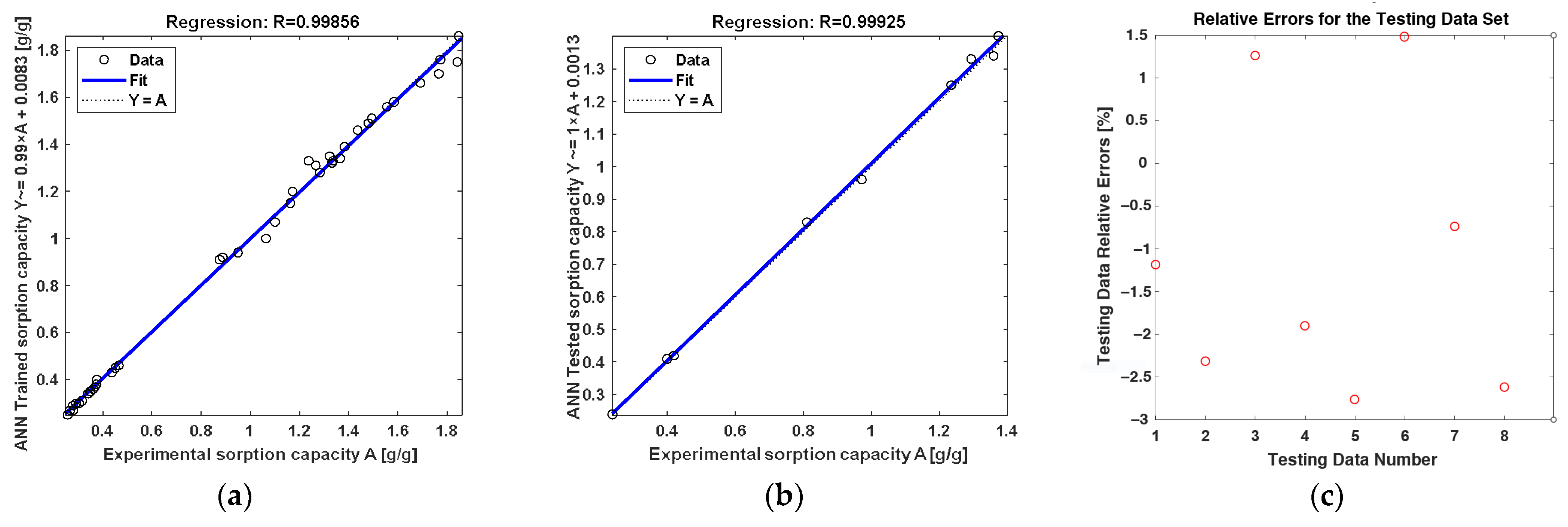
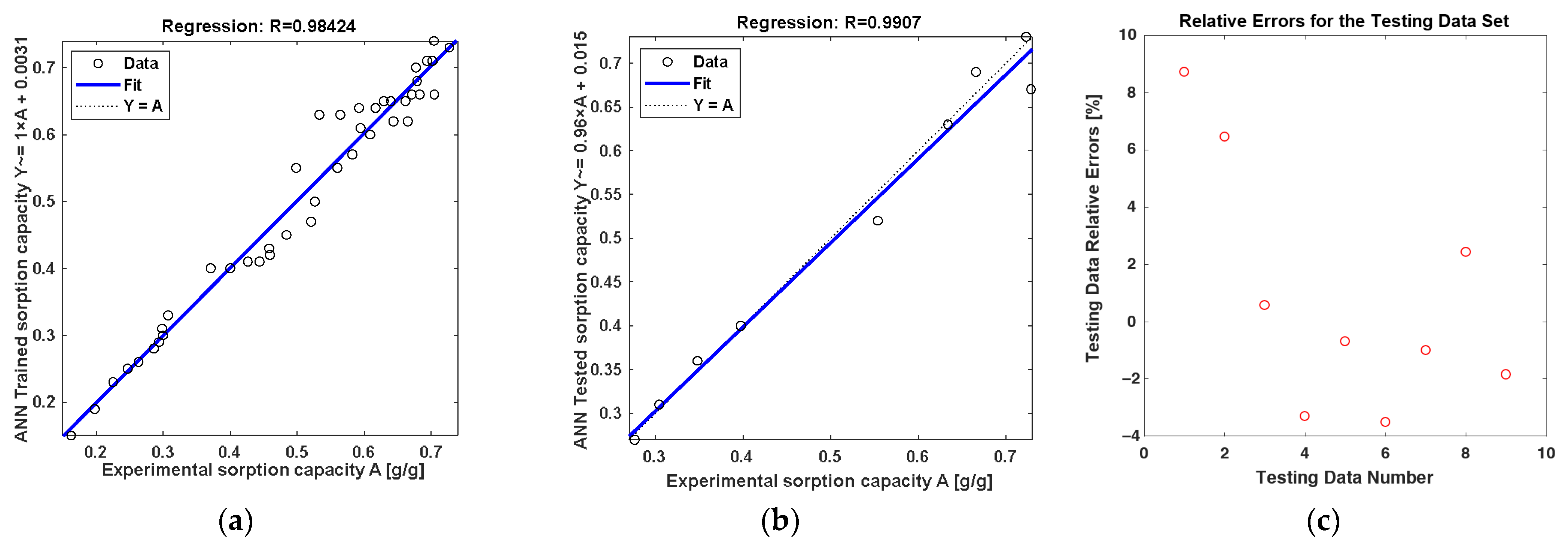
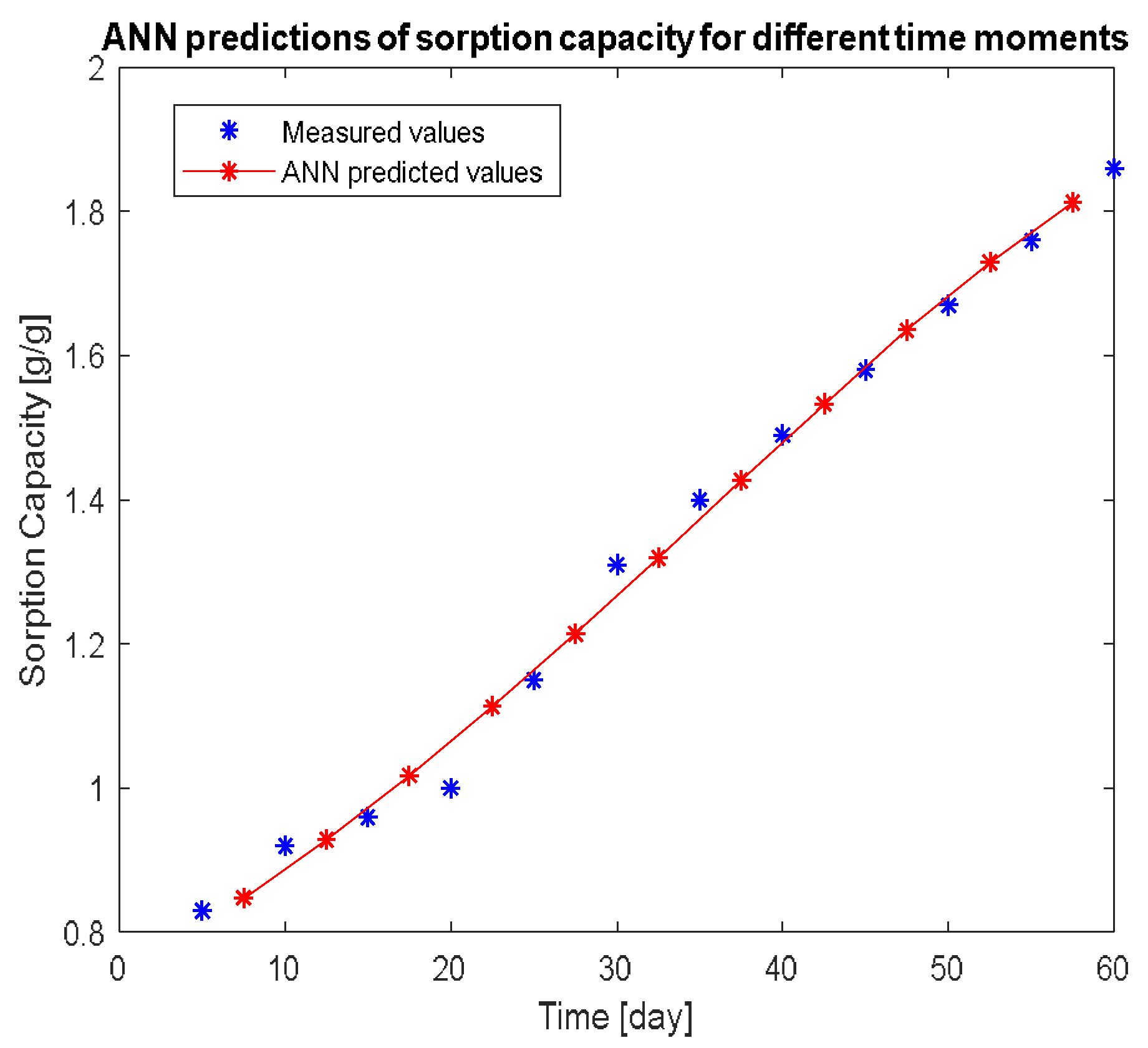
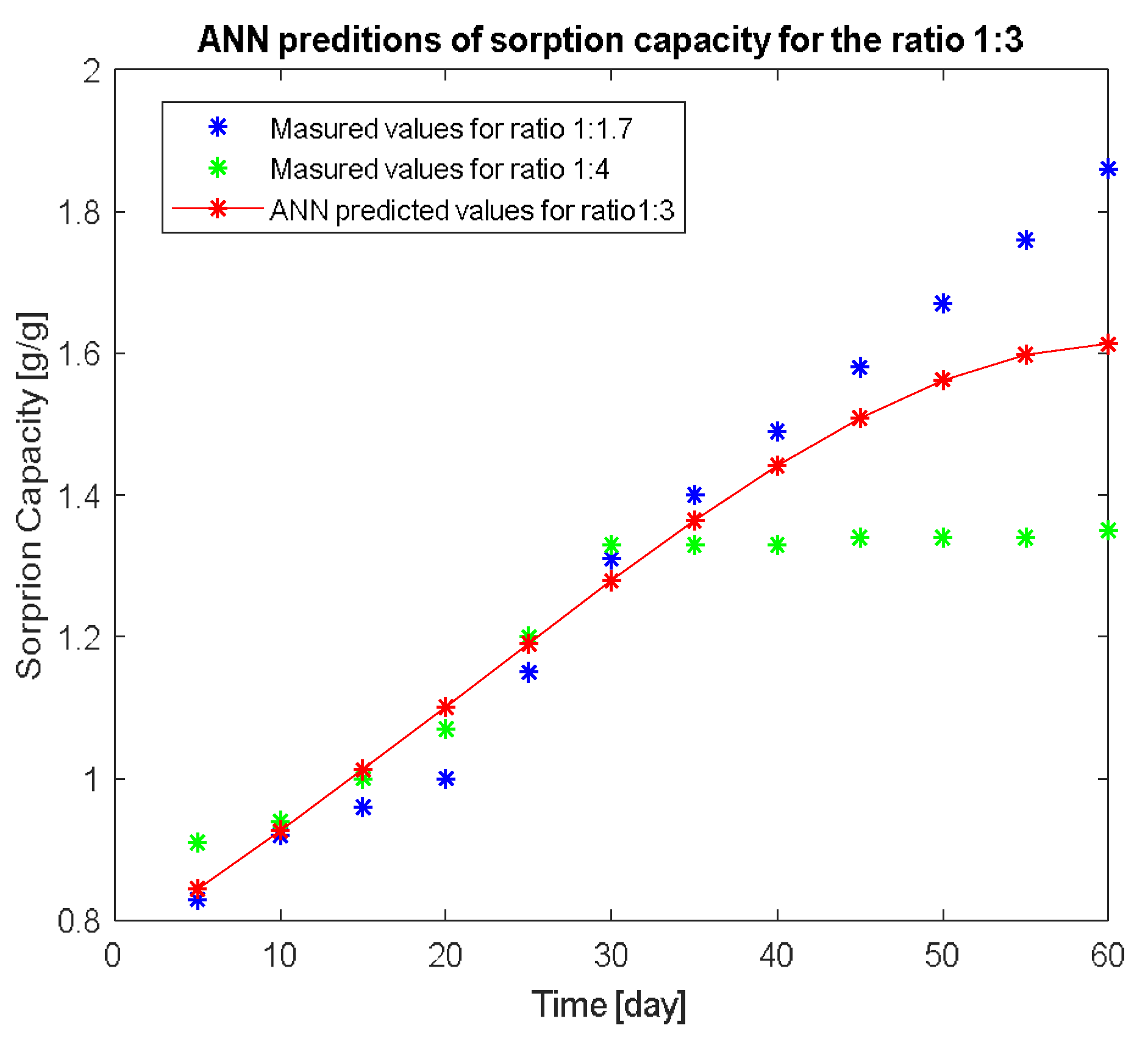
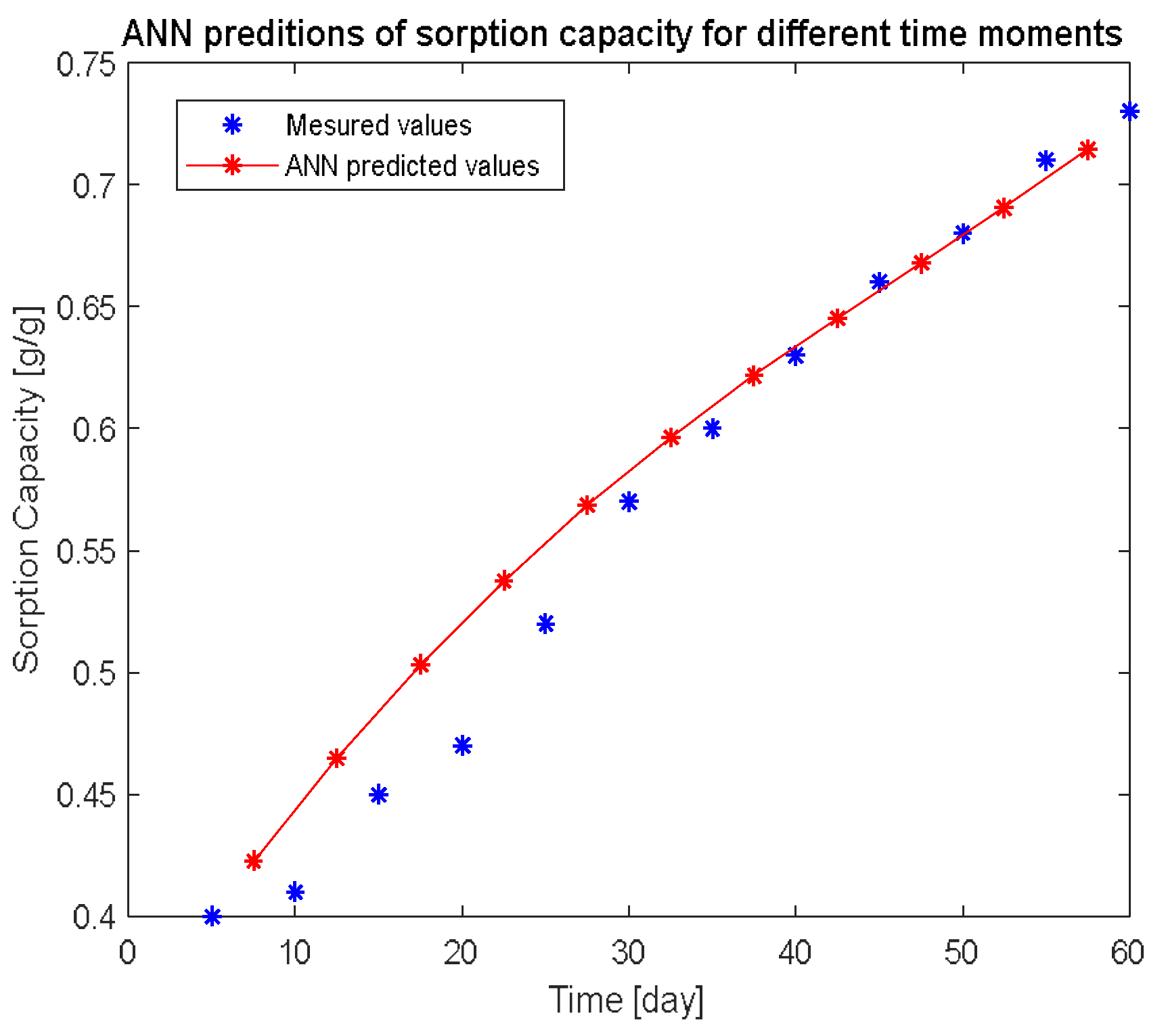
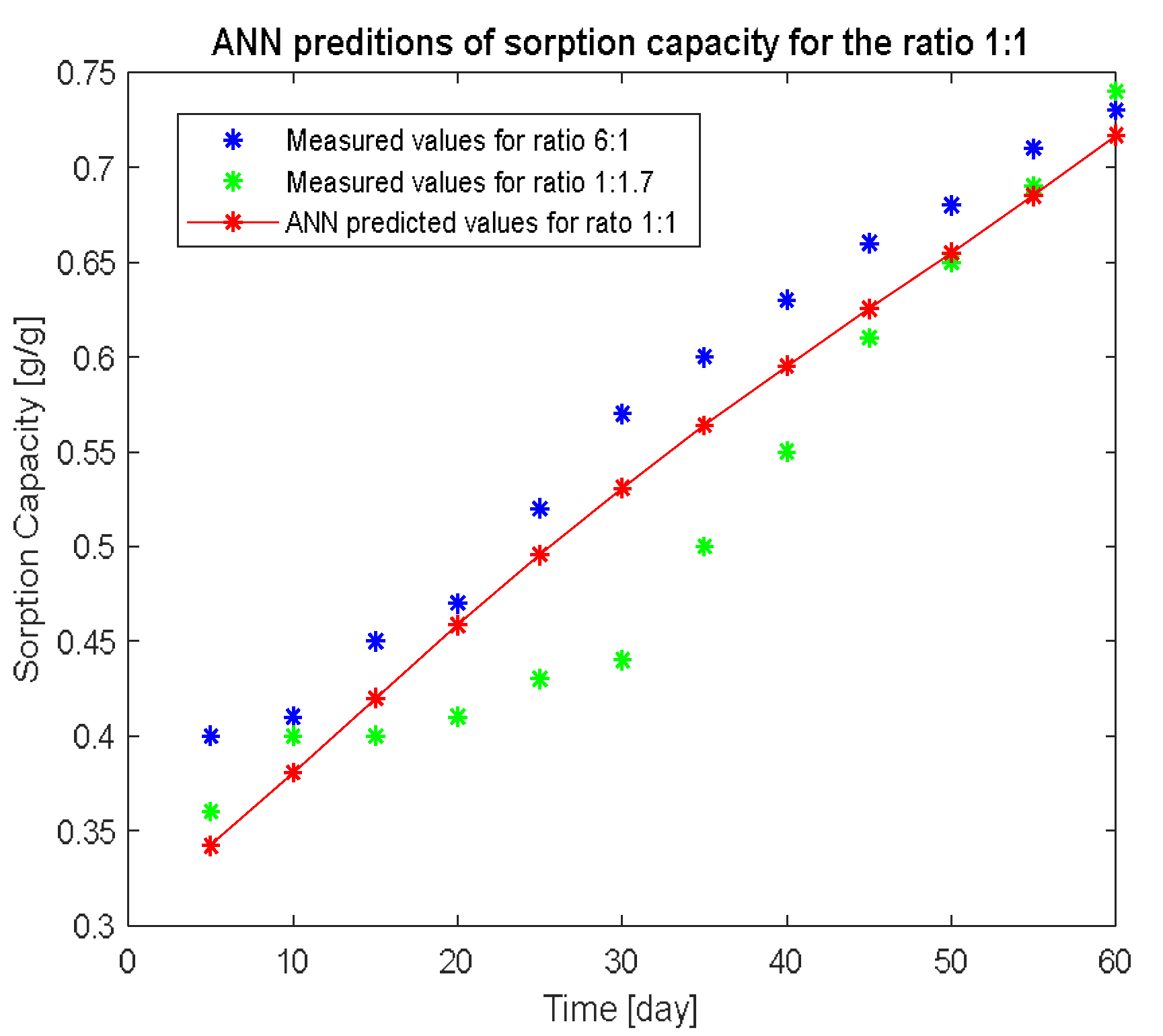
| Time | Shungite | Sh:RH = 6:1 | Sh:RH = 1:1.7 | Sh:RH = 1:4 | Rice Husk | |||||
|---|---|---|---|---|---|---|---|---|---|---|
| Days | 10% | 15% | 10% | 15% | 10% | 15% | 10% | 15% | 10% | 15% |
| Sorption Capacity [g/g] | ||||||||||
| 5 | 0.25 | 0.13 | 0.48 | 0.40 | 0.83 | 0.36 | 0.91 | 0.31 | 0.12 | 0.13 |
| 10 | 0.27 | 0.42 | 1.25 | 0.41 | 0.92 | 0.40 | 0.94 | 0.42 | 0.24 | 0.15 |
| 15 | 0.29 | 0.55 | 1.28 | 0.45 | 0.96 | 0.40 | 1.00 | 0.50 | 0.27 | 0.19 |
| 20 | 0.30 | 0.63 | 1.32 | 0.47 | 1.00 | 0.41 | 1.07 | 0.62 | 0.31 | 0.23 |
| 25 | 0.30 | 0.63 | 1.39 | 0.52 | 1.15 | 0.43 | 1.20 | 0.62 | 0.35 | 0.25 |
| 30 | 0.31 | 0.64 | 1.46 | 0.57 | 1.31 | 0.44 | 1.33 | 0.62 | 0.40 | 0.26 |
| 35 | 0.32 | 0.64 | 1.51 | 0.60 | 1.40 | 0.5 | 1.33 | 0.64 | 0.41 | 0.27 |
| 40 | 0.34 | 0.65 | 1.56 | 0.63 | 1.49 | 0.55 | 1.33 | 0.66 | 0.42 | 0.28 |
| 45 | 0.35 | 0.65 | 1.61 | 0.66 | 1.58 | 0.61 | 1.34 | 0.68 | 0.43 | 0.29 |
| 50 | 0.36 | 0.66 | 1.66 | 0.68 | 1.67 | 0.65 | 1.34 | 0.70 | 0.45 | 0.30 |
| 55 | 0.37 | 0.66 | 1.70 | 0.71 | 1.76 | 0.69 | 1.34 | 0.71 | 0.46 | 0.31 |
| 60 | 0.38 | 0.67 | 1.75 | 0.73 | 1.86 | 0.74 | 1.35 | 0.73 | 0.47 | 0.33 |
Disclaimer/Publisher’s Note: The statements, opinions and data contained in all publications are solely those of the individual author(s) and contributor(s) and not of MDPI and/or the editor(s). MDPI and/or the editor(s) disclaim responsibility for any injury to people or property resulting from any ideas, methods, instructions or products referred to in the content. |
© 2023 by the authors. Licensee MDPI, Basel, Switzerland. This article is an open access article distributed under the terms and conditions of the Creative Commons Attribution (CC BY) license (https://creativecommons.org/licenses/by/4.0/).
Share and Cite
Cristea, V.-M.; Baigulbayeva, M.; Ongarbayev, Y.; Smailov, N.; Akkazin, Y.; Ubaidulayeva, N. Prediction of Oil Sorption Capacity on Carbonized Mixtures of Shungite Using Artificial Neural Networks. Processes 2023, 11, 518. https://doi.org/10.3390/pr11020518
Cristea V-M, Baigulbayeva M, Ongarbayev Y, Smailov N, Akkazin Y, Ubaidulayeva N. Prediction of Oil Sorption Capacity on Carbonized Mixtures of Shungite Using Artificial Neural Networks. Processes. 2023; 11(2):518. https://doi.org/10.3390/pr11020518
Chicago/Turabian StyleCristea, Vasile-Mircea, Moldir Baigulbayeva, Yerdos Ongarbayev, Nurzhigit Smailov, Yerzhan Akkazin, and Nurbala Ubaidulayeva. 2023. "Prediction of Oil Sorption Capacity on Carbonized Mixtures of Shungite Using Artificial Neural Networks" Processes 11, no. 2: 518. https://doi.org/10.3390/pr11020518






